Most guitar players are obsessed when it comes to guitar and all guitar-related gear and accessories, which is why you will often find them talking about different amps, pedals, effects, strings gauges, tuners, capos, gig bags, etc. The list just goes on and on. However, there is one small item, usually made out of plastic, that doesn’t get mentioned as much as should be, because it directly influences the way you play your guitar, and subsequently, the way it sounds. We are talking about guitar picks.

Of course, advanced guitarists are well aware of the importance of the right guitar pick and which type of pick suits which genre of music, as well as playing style, best. If you are a beginner or intermediate guitarist, knowing your picks can help you a lot with your playing and spare you some of the hardship early on. For example, beginners will have a hard time getting a good tone when strumming their guitar if they are using a pick that is too thick, but we will get to that later. Sure, you can take a different route and play without a pick entirely like Mark Knopfler or Richie Kotzen, but it’s going to take you more than the proverbial 10,000 hours to get there. For most intents and purposes, you will need a pick, especially when playing chords.
Once you start looking into different types of guitar picks, you will realize that there is a lot to them, because they can be categorized according to a whole bunch of different criteria.
These criteria include:
- Size/Shape
- Thickness
- Materials
- Texture
In our guide, we will go over all of these and provide you with all the relevant information you’ll need, as well as address some of the most common questions guitar players have when it comes to guitar picks. Keep on reading to find out more.
Guitar Pick Types and Size/Shapes
Since most people don’t give guitar picks much thought, they probably don’t know that there are several different types of guitar picks. Depending on the type of guitar pick you’re using it can affect your playing, as well as your tone. Let’s take a look at the size first:
Bigger picks are more comfortable and easier to hold on to and are often used by beginners, as well as guitar players whose playing style is loose. Because of the larger gripping surface, you don’t need to be as precise. Bigger picks are perfect if you are strumming chords on an acoustic guitar and you don’t need a lot of dexterity in your playing.
Smaller picks, on the other hand, provide you with a lot of precision in your playing and are ideal for players which play a lot of fast runs, solos, and single notes. These are often metal or jazz players.
In terms of shape, there is an endless of weird and unusual pick shapes, but the most important aspect of them all is the very point of the pick, which is what shapes the sound:
- Rounder points have a warmer sound and a softer attack, which is best suited for strumming and acoustics.
- Sharper points have a sharper attack and are ideal for soloing and fast players who require precision and a bright tone.
Although there is an endless number of pick shapes, let’s take a look at the most common types.
1. Standard 351 Pick Shape (Standard and Sharp Tip)
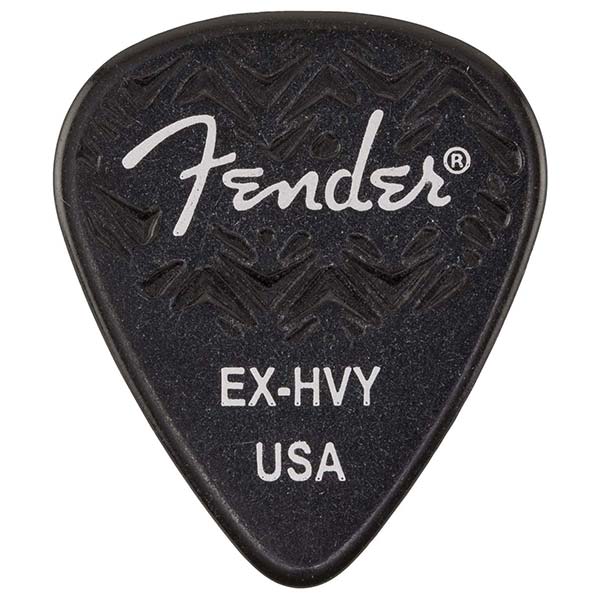
Just like its name indicates, the Standard 351 is a standard guitar pick that will suit you just fine in most playing situations. It’s a favorite among beginners, as well as anyone who prefers strumming with a few single notes thrown in for good measure. If you need more precision on your playing, there is a larger version of the 351 with a sharp tip, which provides you with more precision in your playing.
2. Pointy or Sharp Pick Shape
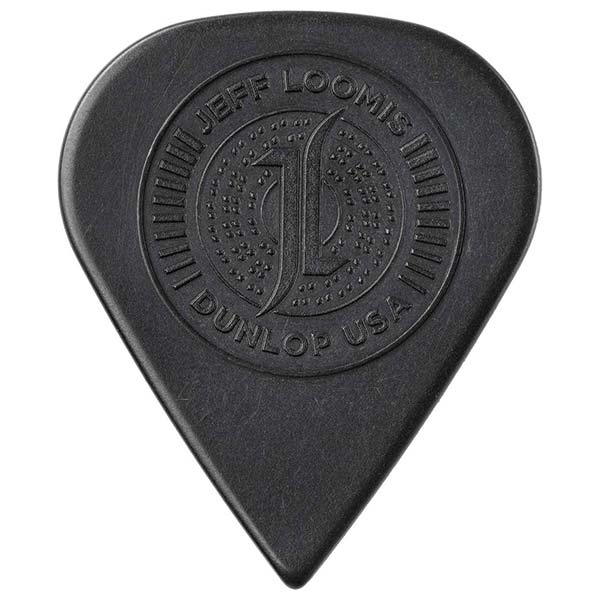
These are similar to standard 351 picks, but whereas standard picks have smooth, rounded edges, pointy picks have edges that are straight and sharp. The same goes for the point, which is designed to give you additional precision when picking single strings. On the other hand, they are less than stellar if your playing features a lot of strumming.
3. Triangle Pick Shape
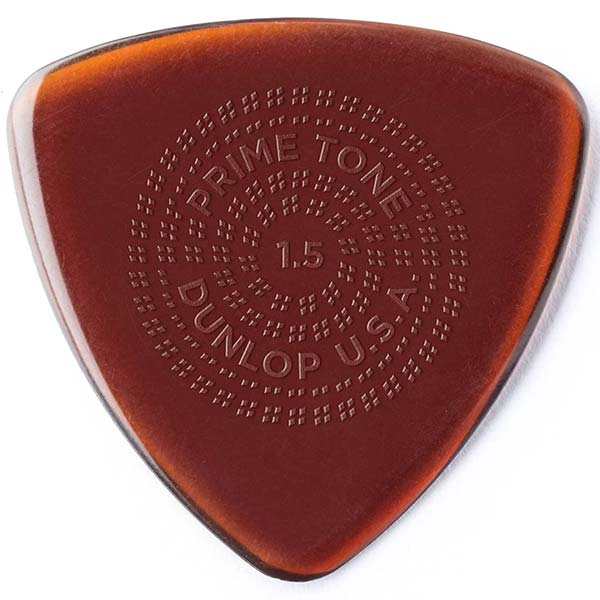
This type of pick shape is less common than the first two and is mostly used by bluegrass players. They work just as well when playing chords or single notes. But, they are larger than most pick types, which means they are less suitable for more aggressive music genres.
4. Shark Fin Pick Shape
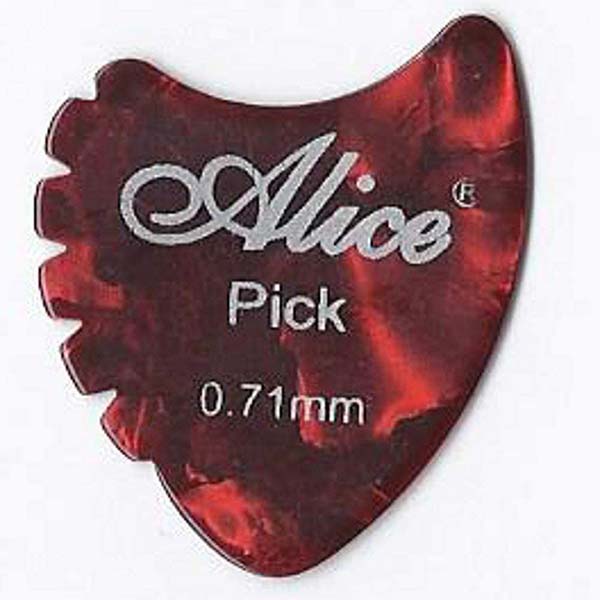
Shark fin picks have a very distinctive shape, but what’s even more interesting about them is that they have one edge with which you can pick the strings, in addition to the point. The edge almost looks serrated, and those small waves enable you to create different sound effects as they hit the strings. As for the tip, it’s rounded, making it ideal for strumming.
5. Jazz III Pick Shape
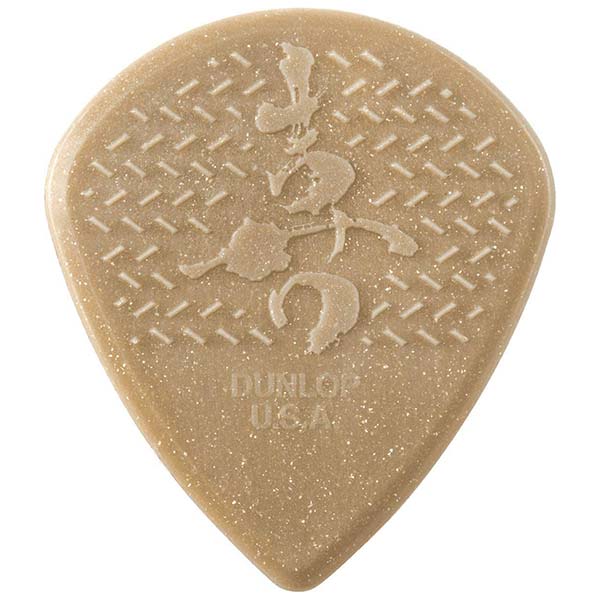
Although these were originally envisioned to be used by jazz players, they are also a favorite among metal guitarists and shredders. Obviously, their shape enables players to play with great precision, as well as speed. Jazz III picks are thicker and smaller than most other picks, which makes them more challenging to use.
6. Teardrop Pick Shape (Thin and Wide)
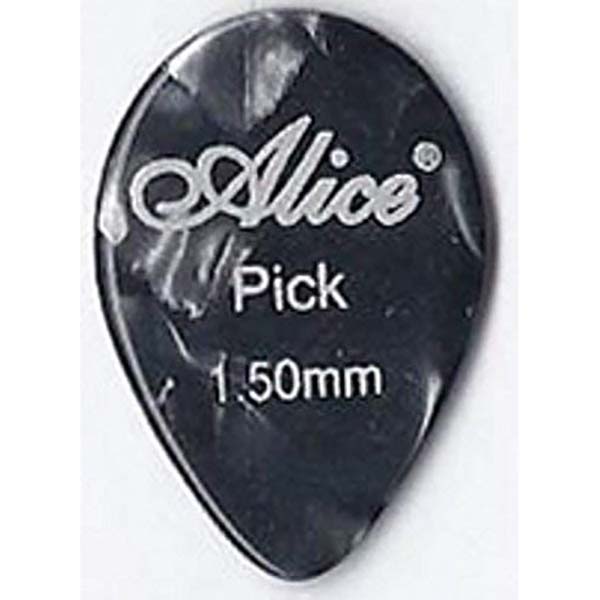
Teardrop picks come in two varieties: thin and wide. Both of these are a variation of the aforementioned Jazz III pick. The thin teardrop is less comfortable, but offers better precision and control, whereas the wide teardrop is more comfortable, but with a softer attack.
Guitar Pick Sizes and Thicknesses Explained
If it matters to you, it does. All joking aside, yes, guitar pick thickness matters, especially if you are a beginner since it can help you get a better tone. Also, some players prefer the feel of a thicker/thinner pick, and believe us, comfort does matter if you are playing or practicing for hours on end.
Thin picks, broadly speaking, are better if you tend to strum a lot, as well as if you are looking for a tighter dynamic and less volume. They also tend to bring out brighter tones.
Thick picks are better suited for deeper, mellower tones, since they bring out the bass tones, as well as if you are looking for a wider dynamic range, sharper attack, and more volume. Since their thickness makes them more rigid, they are ideal for electric guitar players which love fast runs and solos.
Here are the different guitar pick thicknesses:
- Extra light (under 0.40 mm)
- Light (0.40 mm – 0.63 mm)
- Medium (0.63 mm – 0.85 mm)
- Heavy (0.85 mm – 1.22 mm)
- Extra heavy (1.22+ mm)
Let’s look into each one of these types individually.
1. Extra Light / Extra Thin Guitar Picks
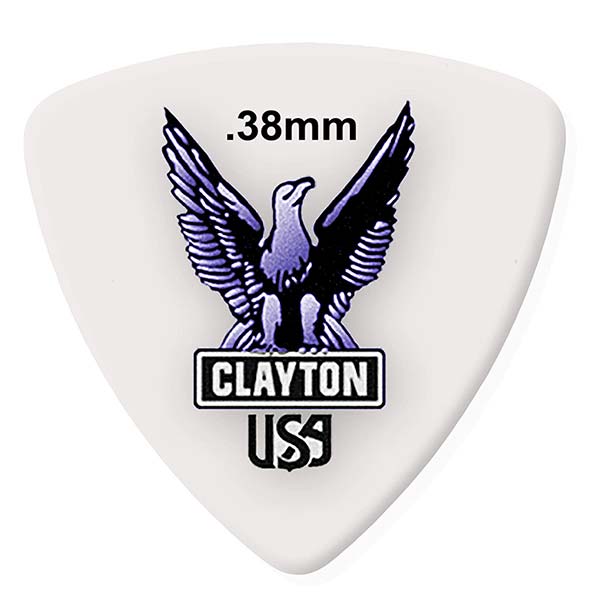
Extra light picks are the thinnest picks of them all and are great if you are looking for an even sound on all of the strings. But, while their softness makes them very forgiving, they tend to produce a somewhat compressed sound that is lacking in punch and resonance. They are a good choice if you are playing an acoustic guitar, but keep in mind that because these picks flex a lot, so they brush against the strings and produce a plasticky sound, which some guitarists find irritating. If you are playing single notes and solos, you will need a pick that can help you produce a more rounded sound. On the other hand, they are great for beginners looking to learn the basics of good rhythm playing.
2. Light / Thin Guitar Picks
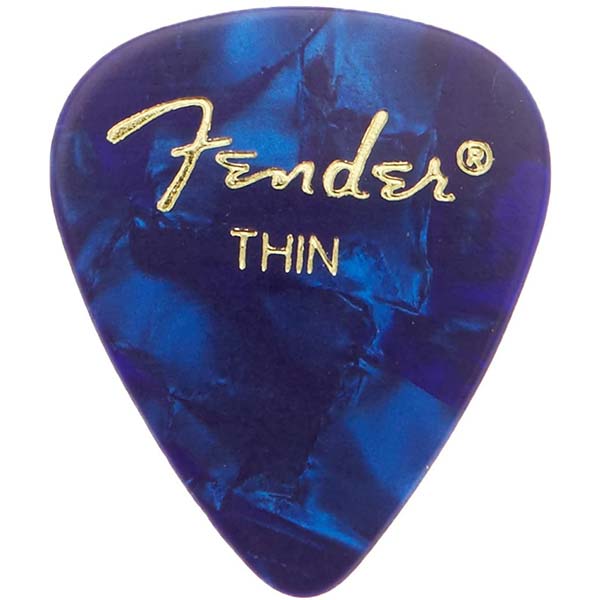
If you don’t like the sound that extra light picks make, but you still want to play an acoustic guitar, light guitar picks are the best option out there. They don’t make that annoying sound, but they still have enough give and flexibility which you need for strumming. On the other hand, if you play harder, they will make your strumming louder, which means you can easily vary your attack on the strings. However, if you are playing a genre that requires a clearly defined and forceful note, such as metal, you are better off with a thick guitar pick.
3. Medium Guitar Picks
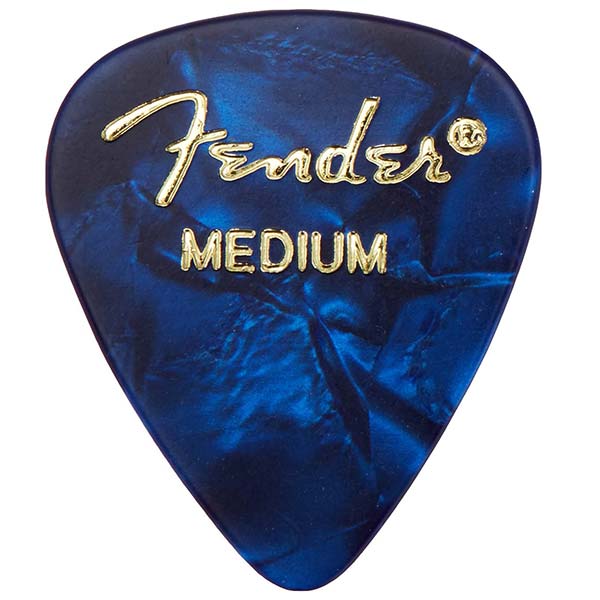
The majority of guitarists rely on medium picks since they provide a good balance between flexibility and stiffness. In terms of sound, they provide a good middle ground between brighter tones and mid-rage fullness and tend to emphasize bass frequencies a lot less. Because they cover all of your basic needs as a guitar player, they are really suitable for beginners. As in the case of thinner picks, if you are playing music that is more aggressive and requires a heavier attack, you should opt for a thicker pick.
4. Heavy Guitar Picks
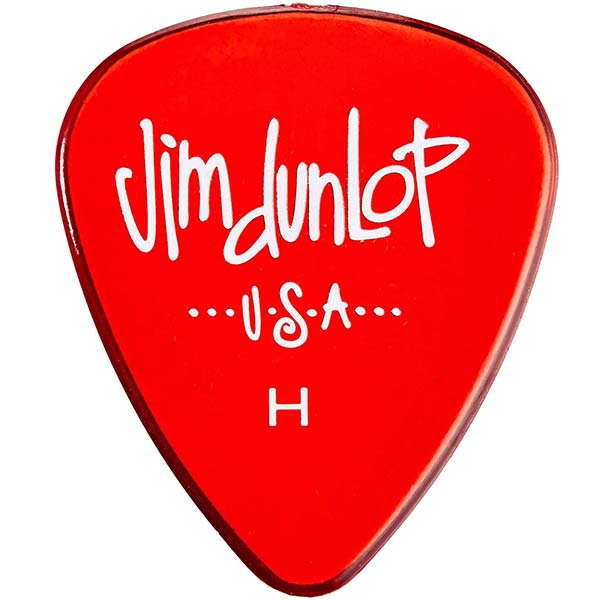
If you are all about having better control of your tone, as well as being louder, then you should definitely go with a heavy guitar. Unlike extra thin or thin picks, heavy guitar picks emphasize bass and mid-range, which makes for a very warm, full sound. They are the opposite of extra light picks in terms of dynamic range. Whereas thinner picks are helpful if you want a tighter dynamic range, heavy picks enable you to access more of it, due to more forceful picking and string vibration. The tradeoff with heavier picks is that they feel less flexible and more blocky, and if your attack on the strings is heavier, dropping them is not uncommon. But, if you know how to use them, the control that they provide you with makes up for all the potential disadvantages. They are ideal if you are playing bass or electric guitar
5. Extra Heavy Guitar Picks
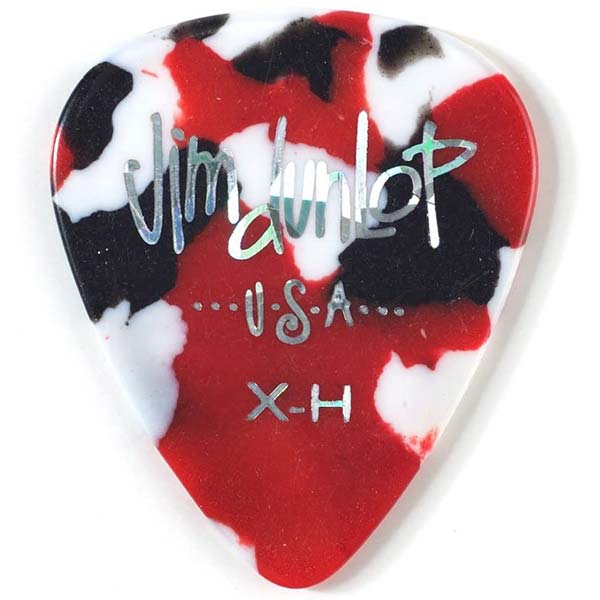
Finally, we come to extra heavy picks, which are usually upwards of 1.2 mm in thickness, and with some of them easily being more than 2 mm thick. You will also come across picks that are 3.5 mm, which are usually used for gypsy jazz, or any other genre or style where you need to apply more force to the string or if you want more volume in your playing. Extra-heavy picks are also used by bass players, as well as electric guitar players which want more control over their tone. The disadvantage of using extra heavy picks is that they can be easily dropped if you aren’t holding onto them tightly. Therefore, they are not recommended for beginners or acoustic guitar players.
Guitar Pick Materials Explained
This is arguably the most important characteristic of any guitar pick because the material itself plays a huge role in how the picks will behave, and also determines its flexibility, texture, and overall feeling in your hands. Obviously, you can pretty much make a pick out of anything, but certain materials will perform better, depending on the circumstances. Over the course of music history, picks have been made out of so many different materials, it’s almost impossible to list them all. However, some of the most common guitar pick materials are:
- Celluloid
- Nylon
- Acetal aka Delrin
- Tortex
- Ultex
- Stone
- Metal Wood
- Felt
- Bone, Ivory, and Ebony
- Tortoise Shell
Let’s take a closer look at some of these popular pick materials.
1. Tortoise Shell Guitar Picks
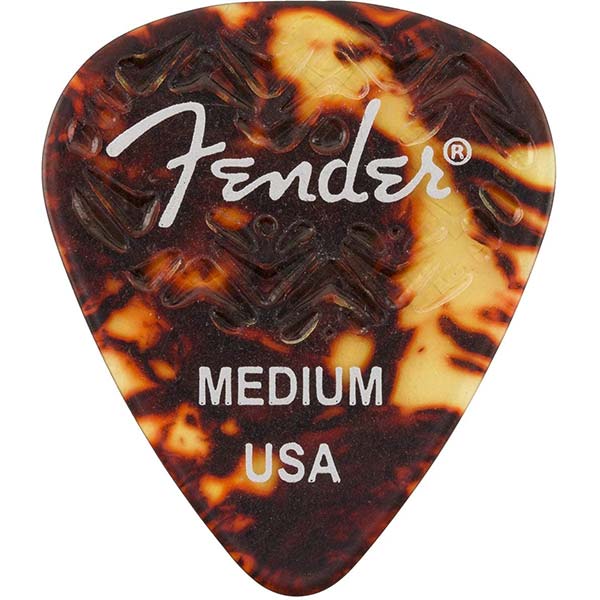
This is arguably the most coveted pick material among guitar players because it’s supposed to offer unparalleled control and warm sound. However, these picks are made out of a shell of a Hawksbill turtle, and the last one of them was made in the 1970s, after which they were banned. Apart from the superior tone and comfort, tortoise shell picks are also extremely durable and can last for years before, and even when they wear down a bit, they can be reshaped. The same cannot be said for other materials such as nylon or celluloid. The downside is that they are almost impossible to find, and depending on where you live, they might even be illegal.
2. Celluloid Guitar Picks
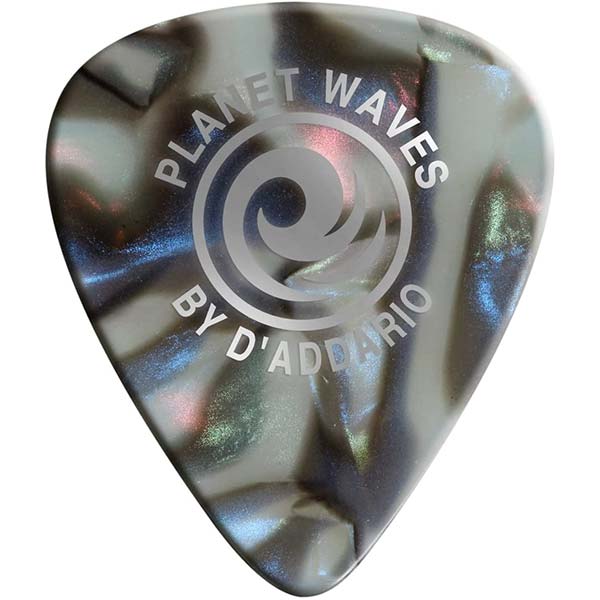
Celluloid picks were developed as a replacement for banned tortoise shell picks since they were supposed to offer a similar tone and ease of playing. However, while they check most of the boxes celluloid picks are less rigid than tortoise shell picks. They are still stiffer when compared to nylon picks. In terms of sound, the tone you get with cellulose picks is very crisp and balanced. When it comes to looks, they are usually designed to mimic the texture of tortoise shell picks, but in a huge variety of colors, as well as with logos and designs printed on them. The downside is that they wear down over time. They are also flammable, but that shouldn’t be an issue in most playing situations.
3. Nylon Guitar Picks
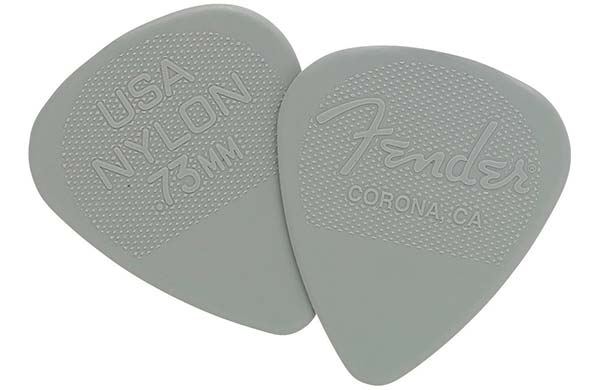
Another popular pick material is nylon. Nylon picks have been by numerous guitarists throughout the decades, as many prefer the flexibility that nylon provides them with. When it comes to sound, the jury is still out on whether nylon produces a warm or bright sound, so you will have to see it for yourself. While their flexibility makes them very comfortable, they tend to be very slippery, which means you should opt for one which has a gripping edge. Also, they wear down faster than picks made out of stronger and stiffer materials.
4. Tortex Guitar Picks
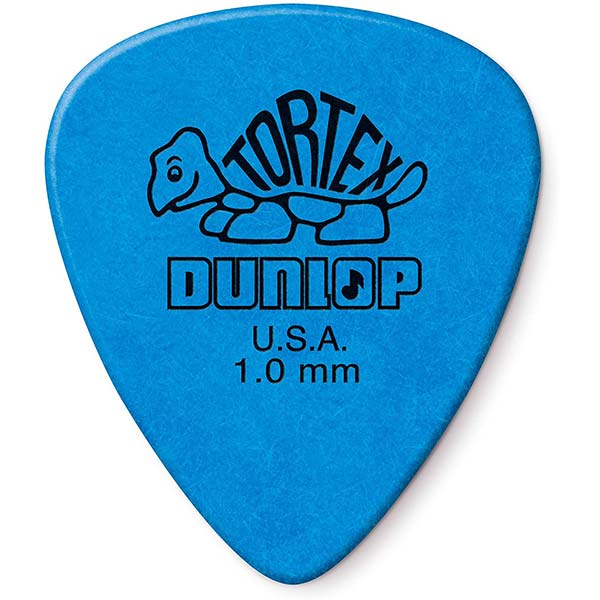
If you are looking for a pick that closely mimics a tortoise shell (hence the name), you might want to look into ‘Tortex’, which is a material developed by Dunlop. Obviously, no turtles were harmed in the making of these picks. They offer a very good grip, and if you are a fast player, you will love them. One thing you will also notice about these picks is that their surface is covered with powder, which additionally helps you maintain grip regardless of how complex or fast the tune.
5. Ultex Guitar Picks
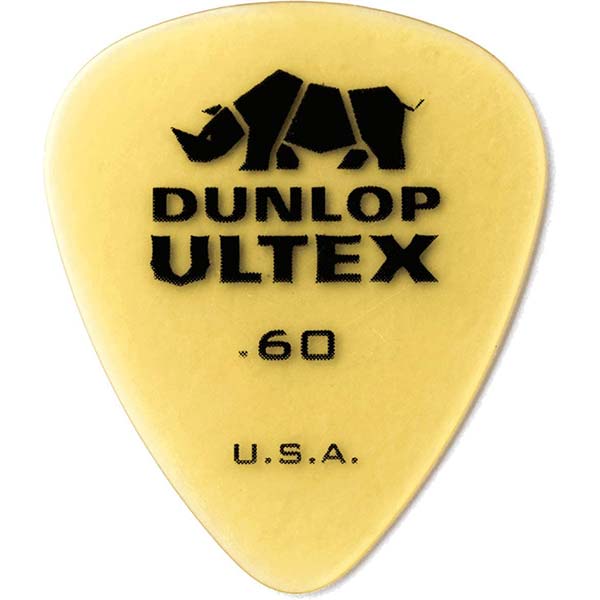
Ultex, or Ultem, is another material developed by Dunlop, which has all the flexibility of Tortex but enables you to have a sharper attack. Ultex picks are still relatively lightweight, which means you won’t be using them for metal, but they do help you get a balanced tone. They are also very durable. The material itself is very sturdy and resistant to high temperatures. In other words, they can withstand anything you can throw at them. They provide tons of grip, especially if their edge is designed to be grippy.
6. Delrin Guitar Picks
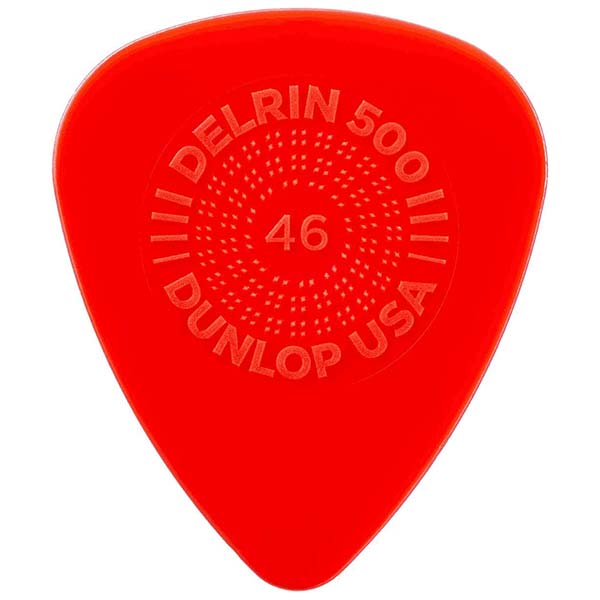
Delrin, or acetal picks, are made out of plastic created by DuPont. However, there is a lot of confusion regarding this material, because Delrin is basically the very same plastic that is used to make Tortex picks. So why two different names if they are essentially the same? Well other than the fact that each pick brand has come up with their own name, these two materials differ from one another based on how they feel in your hands. Whereas Delrin has a fairly smooth texture, Tortex, as we have already mentioned, has a grippier texture and a powdered surface that almost feels like chalk. Basically, Tortex is Ultex with a textured surface. It all comes down to personal preference.
7. Stone Guitar Picks
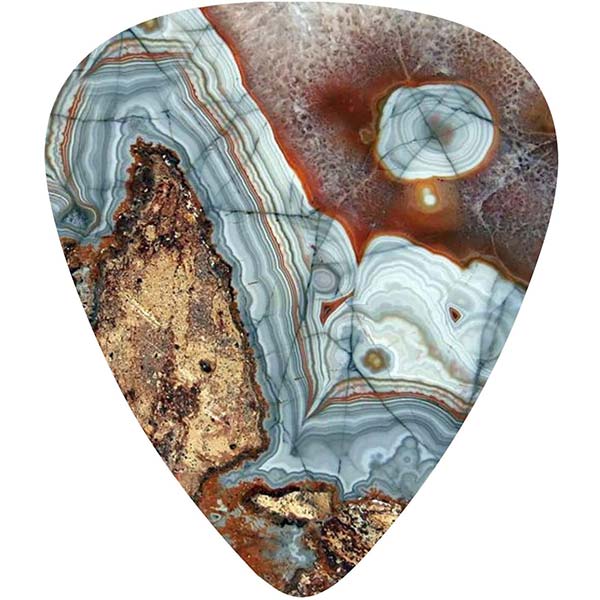
Although stone picks are not very common, they are excellent if you are looking for picks that are extra rigid. It is that stiffness that enables you to get a unique sound from your playing since you can squeeze out extra harmonics. Also, the resulting sound is very loud and balanced. Depending on the kind of stone that was used to make them, these picks can also look pretty eye-catching. However, since they offer zero flexibility, they are better for playing single notes rather than chords. On the other hand, their texture allows for fantastic grip. Their price is often pretty steep since they are hand-made. If you are playing an electric guitar, stone picks can be a great choice.
8. Wooden Guitar Picks
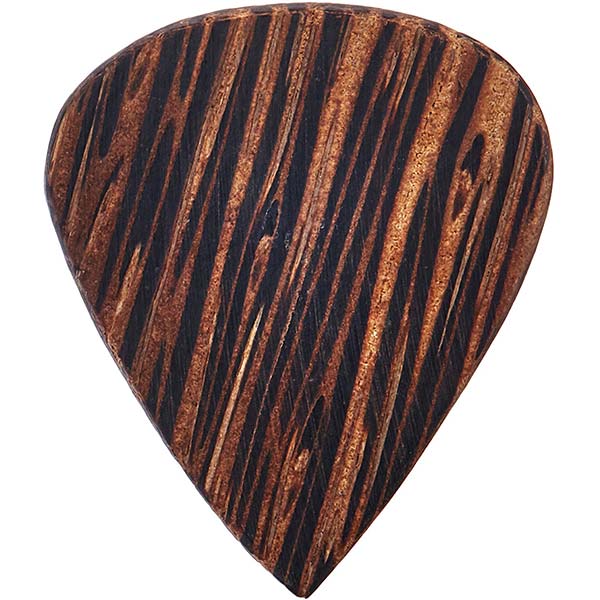
Wooden guitar picks produce a very warm tone, and are made out of hardwoods that are used to build guitars. We are talking about rosewood, walnut, Mahogany as well as Cherry. Usually, you can choose between two different designs: Sheesham and surf, Sheesham picks are made from tough woods that produce a somewhat brighter sound. Surf picks are made out of an extremely tough type of wood called Lignum Vitae. They are difficult to play with to an extent since they tend to be pretty thick. Wooden picks also wear down more quickly than their plastic or stone counterparts and therefore need to be replaced more often.
9. Metal Guitar Picks
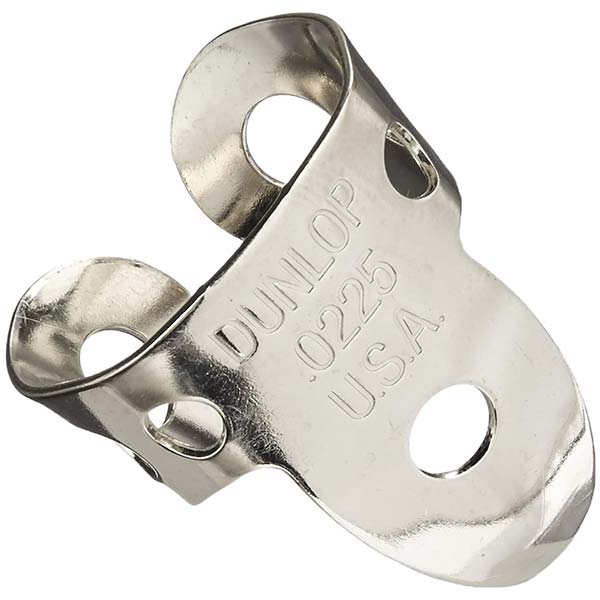
If you prefer picks which can help you access those upper, brighter tones and harmonics, as well as have a sharp attack, you should definitely check out metal picks. The most common materials used to manufacture metal picks are steel, brass, and copper. Of course, the softer the metal, the warmer the tone. Steel picks are the most durable. In fact, they will outlast your strings, and might even break them with prolonged use. There are steel picks with rounded edges, which minimize that effect. The downside is that they are very thick.
10. Other Materials
Picks made out of bone, ivory, and ebony are hard to find since these materials are banned and/or illegal in most countries. These have a very coarse surface, which can be an issue since they can scrape against the strings. On the other side of the spectrum are felt picks, which are usually made out of wool or cotton. Obviously, they are very soft and bendable and have a very weak attack. This can be a favorable quality if you are playing the ukulele.
Guitar Pick Textures
If you have at least some experience playing guitar, you have probably dropped your pick numerous times. While some players are able to adjust to any kind of pick, others are very particular about the kind of texture their pick of choice needs to have. For instance, polished, smooth picks are good for most guitar players, unless they start to sweat. In that case, they might opt for picks that provide them with more grip, such as those made out of Tortex.
As we have pointed before, Tortex has a powdered surface, but if you are looking for extra grip, you may also want to check picks made out of stone, which have a coarser texture. Finally, nearly all pick manufacturers have textured picks that have raised areas that provide additional grip.
Guitar Picks FAQs
Are Certain Picks Better for Strumming Metal, Jazz, etc?
Yes, certain picks are better for playing metal, jazz, rock, and other music genres on the guitar. For example, blues and early rock will benefit more from the use of nylon guitar picks because of the warmer, brighter, and mellower tones that the pick produces.
Delrin plastic picks, on the other hand, are perfect for strumming heavy metal. These guitar picks are quite stiff. Their stiffness allows the picks to produce a higher-pitched tone that heavy metal music requires. You will also need a pick with a large thumb hold and a moderate pointy tip.
If you want sweep picking and fast shredding guitar solos, then you need a very stiff pick with a pointy tip and a tapered edge. This allows you to obtain maximum note definition and speed off the guitar strings.
What Guitar Pick Shape is Best for Beginners?
There are no hard rules as to which guitar pick shape is best for beginners. If you are comfortable playing your guitar with it, then any shape would suffice. It is important to remember that pick shape is more concerned with grip comfort or how comfortable you are holding the pick.
In general, many beginner guitar players are very familiar with the heart-shaped pick. pick manufacturers mark this guitar pick shape as ‘351’. The pick features a beveled and sharpened tip that allows for smoother and more accurate guitar playing. If the beginner guitarist has stubby fingers, he will need a larger-sized, heart-shaped pick.
What Thickness of Guitar Pick is Best for Beginners?
The thickness of the pick that is best for beginner guitar players depends on their playing technique. For example, if you prefer to strum all your guitar songs, then a thin pick is ideal. This allows you to produce a rich sound that has a beautiful ‘zing’ across the guitar strings. It is also a lot easier to control. This is perfect for performing the combination of downstrums and upstrums.
Advanced beginners can opt for a pick with medium thickness between 0.55 and 0.73 millimeters. Beginner guitarists who are trying to learn the basics of chord picking can also choose a medium-thickness pick. Chord picking produces sounds that are quieter or softer than strumming because you only pick one string at a time. A medium-thickness pick will bring the volume of the sound at a more audible level. Using a thin pick for chord picking can hit the wrong string because of its tendency to flex.
Beginners who play electric guitars should pick a pick with a thickness of about 0.9 to 1.1 millimeters. This is ideal for playing rock, metal, and jazz songs. It produces a boomy sound, something that will benefit these genres of music.
What Guitar Pick Models/Brands Would you Recommend for Beginners?
Most guitar instructors recommend the Dunlop Nylon series of guitar picks to their students. These picks come in different shapes, sizes, and thicknesses to provide the newbie guitarist with plenty of options. The main advantage of nylon picks is that they have greater flexibility compared to other types of plastic picks.
Another brand that we can recommend to beginner guitar players is Fender. This company is known for its celluloid picks. It is a good choice for guitar players who want a classic tortoiseshell design. It is stiffer than a nylon pick and more flexible than a real tortoiseshell. It produces a brighter, snappier tone. You can get the Premium Celluloid guitar picks variety pack of Fender if you want.
Dunlop is another brand that is perfect for beginner guitarists. They are famous for their Tortex model of picks that feature the DuPont-made Delrin plastic. This pick is popular for its powdery feel, allowing you to hold the pick more securely.
Can I Play Guitar Without a Pick?
Yes, you can always play your guitar sans a pick. Everything depends on your musical style. Some guitarists cannot do without a pick. For example, most electric guitar players prefer using a pick to give them more precise attacks. Even guitarists who are fond of the fingerstyle use a special kind of pick.
Which Type of Guitar Pick is Best for Metal?
Playing metal songs requires a strong pick attack. It needs to be both powerful and concise. Heavy metal songs require a lot of fast playing that can include thrash-style rhythms and shredding. The pick should influence the string reverberations that the guitar pickup processes.
It is for this reason that heavy-gauge or thick picks are ideal for metal songs. Such a pick allows you to apply your picking force directly to the guitar strings. It also allows greater control, especially when ripping through the chords on the strings.
Another consideration is the edge and end of the pick. Some metal guitar players prefer picks with pointy ends or tips. This allows them to attack faster. There are also heavy metal guitarists who prefer a sharp edge, instead of a pointy tip.
What size of Guitar Pick is Best for Beginners?
There is no standard size for beginner guitar players. You should always choose a pick that you are most comfortable playing. One way to determine the most appropriate pick size for you is by looking at your fingers. In general, the thumb and index finger should rest squarely on the pick. There should still be ample space for these two fingers to move about while holding the pick. This is important to prevent finger fatigue.
Why is Pick Grip Important?
One of the most often overlooked aspects of a good guitar pick is texture. That is why the best picks will have a textured surface. The pick should have at least a thumb portion that offers exceptional grip. Some manufacturers use a special embossing on the pick’s surface.
Playing the guitar with a pick requires a firm grip of the pick. You will not be able to play as effectively as you want if the pick keeps slipping from your fingers. You may think of holding the pick firmly between your thumb and index finger to keep it from slipping. The problem with such an approach is that you can strain your fingers and produce cramp-like sensations.
And there you have it, everything you need to know about guitar picks. Even though they might seem like an insignificant piece of plastic, or whichever material it is made out of, picks have a big role when it comes to playing style, attack, precision, tone, and comfort. We hope that this guide will help you find the right pick for yourself. Good luck!
In this article, we cover everything you could ever want to know about the different types of guitar picks. We cover shapes, sizes, thicknesses, materials, and more!

My name is Chris and I’ve had a passion for music and guitars for as long as I can remember. I started this website with some of my friends who are musicians, music teachers, gear heads, and music enthusiasts so we could provide high-quality guitar and music-related content.
I’ve been playing guitar since I was 13 years old and am an avid collector. Amps, pedals, guitars, bass, drums, microphones, studio, and recording gear, I love it all.
I was born and raised in Western Pennsylvania. My background is in Electrical Engineering, earning a Bachelor’s degree from Youngstown State University. With my engineering experience, I’ve developed as a designer of guitar amplifiers and effects. A true passion of mine, I’ve designed, built, and repaired a wide range of guitar amps and electronics. Here at the Guitar Lobby, our aim is to share our passion for Music and gear with the rest of the music community.

Thanks for the insight, Chris. I am a chronologically advanced learn to play guitar person. My progress is slow but enjoyable. Like you, an engineer and everything has to be investigated as i have no knowledge of music. I recently was given stuff which I later investigted to one of Ernie Balls learn to ply guitar phase 2 books, the history of which was explained by his grandson on youtube. As well as this I was given a large packet of picks. I am sorry to say they were tortoiseshell types of varying shapes and sizes. Your article provided a great insight but didn’t cover the curved shaped picks. These were standard size but curved with a cork grip. Have you come across these? what are they used for?
One cannot state pros and cons for plectra without taking into consideration the type of instrument, Electric guitar, acoustic flat top guitar, archtop (acoustic) guitar, or manouche style guitar. My area of best expertise is with acoustic flat top guitar.
Many/most beginners opt for thin 351 style, as their activity is largely limited to a windscreen wiper style of strumming. I regard any pick thickness less than 1 m/m as “thin”. For more detailed strumming, “flatpicking” and hybrid styles, I regard 1 m/m to 1.5 m/m as medium , and over 1.5 as heavy, but there is no “industrial standard. The shapes are now mostly the 351 or “teardrop” but the 346 large is gaining in popularity as it offers tree points (sic) and more mass than an equivalent 351 thickness. For jazz and manouche style 2 or even 3 m/m is not uncommon. There are too many composites on the market to discuss here, but currently “vespal” is mostly considered the best. One final note on the supposed holy grail of tortoiseshell. (I have a fair collection of pre ban picks, and it is not as “wonderful” as some might think. It wears rapidly and can tend to crack/break. Modern composites that provide a slight flexibility and low resistance will be the best option.